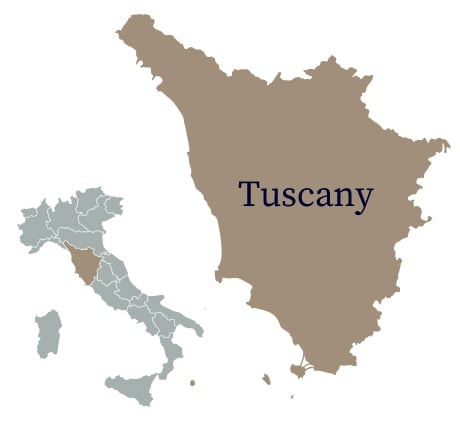
Siena, Pisa, Lucca, and Florence; Chianti classico wine and olive oil; truffles and freshly made pasta; and a particularly rich Renaissance history — in so many ways, Tuscany is all of Italy’s quintessential appeal wrapped up into one tasty, attractive and story-filled region.
But when it comes to the cuisine, it’s hard to deny that Tuscany really shines. Italians have historically classified Tuscan food as cucina povera, meaning “poor cooking” or essentially peasants’ food. The culinary tradition here dates back to the Etruscans, who maximized the fertile soil and sea for everything from veggies to legumes, fruit, seafood, chicken, beef, pork and more.
The Etruscan legacy of living off the land carries on today, too, with local dishes emphasizing quality and simplicity over elaborate recipes that might mask the perfection of nature’s bounty. For that reason, expect traditional antipasti to be heavy on cold cuts, and first courses that feature humble ingredients, such as the popular bread-inspired dishes ribollita and panzanella.
Pastas plates, on the other hand, might get dressed up with the region’s prized truffles, or be more heartily topped by game-based sauces. Meanwhile main courses range from seafood to more game and meat, the highlight of which is arguably the T-bone steak bistecca alla fiorentina.
As for post-meal indulgences, Tuscans traditionally treat themselves to sweets including biscotti-style cantucci, fruitcake-like panforte or panpepato, and sips of the region’s favorite sweet wine Vin Santo.
Wines of Tuscany
Speaking of wine, Tuscany’s landscape features both a coastline and countryside ideal for grape growing, and which therefore has a thousand-year history of wine production.
As the undisputed home of Sangiovese, Tuscany is known worldwide for its reds. Most famous among these regions is Chianti Classico, which produces wines that represent the very essence of Tuscan Sangiovese. Floral, fruity, crisp, fresh and dynamic, they go perfectly with heavier local cuisine, especially the aforementioned bistecca alla fiorentina.
Then there’s the Sangiovese-based Brunello di Montalcino wines, whose lengthy aging in wooden barrels lend to soft, slightly spicy flavors that marry well with soups, braised meats, and cheeses. Honorable mention goes to other regional reds including Vino Nobile di Montepulciano and Morellino di Scansano, both which demonstrate the versatility of Sangiovese.
But not only Tuscan reds deserve our attention: Vernaccia di San Gimignano, a rich and harmonious white, is perfect as an aperitif, perhaps paired with a plate of cold cuts and cheeses. And the list very much goes on, making it clear that — from wine to food and more — there’s a lot to toast to in Tuscany.

Siena, Pisa, Lucca, and Florence; Chianti classico wine and olive oil; truffles and freshly made pasta; and a particularly rich Renaissance history — in so many ways, Tuscany is all of Italy’s quintessential appeal wrapped up into one tasty, attractive and story-filled region.
But when it comes to the cuisine, it’s hard to deny that Tuscany really shines. Italians have historically classified Tuscan food as cucina povera, meaning “poor cooking” or essentially peasants’ food. The culinary tradition here dates back to the Etruscans, who maximized the fertile soil and sea for everything from veggies to legumes, fruit, seafood, chicken, beef, pork and more.
The Etruscan legacy of living off the land carries on today, too, with local dishes emphasizing quality and simplicity over elaborate recipes that might mask the perfection of nature’s bounty. For that reason, expect traditional antipasti to be heavy on cold cuts, and first courses that feature humble ingredients, such as the popular bread-inspired dishes ribollita and panzanella.
Pastas plates, on the other hand, might get dressed up with the region’s prized truffles, or be more heartily topped by game-based sauces. Meanwhile main courses range from seafood to more game and meat, the highlight of which is arguably the T-bone steak bistecca alla fiorentina.
As for post-meal indulgences, Tuscans traditionally treat themselves to sweets including biscotti-style cantucci, fruitcake-like panforte or panpepato, and sips of the region’s favorite sweet wine Vin Santo.
Wines of Tuscany
Speaking of wine, Tuscany’s landscape features both a coastline and countryside ideal for grape growing, and which therefore has a thousand-year history of wine production.
As the undisputed home of Sangiovese, Tuscany is known worldwide for its reds. Most famous among these regions is Chianti Classico, which produces wines that represent the very essence of Tuscan Sangiovese. Floral, fruity, crisp, fresh and dynamic, they go perfectly with heavier local cuisine, especially the aforementioned bistecca alla fiorentina.
Then there’s the Sangiovese-based Brunello di Montalcino wines, whose lengthy aging in wooden barrels lend to soft, slightly spicy flavors that marry well with soups, braised meats, and cheeses. Honorable mention goes to other regional reds including Vino Nobile di Montepulciano and Morellino di Scansano, both which demonstrate the versatility of Sangiovese.
But not only Tuscan reds deserve our attention: Vernaccia di San Gimignano, a rich and harmonious white, is perfect as an aperitif, perhaps paired with a plate of cold cuts and cheeses. And the list very much goes on, making it clear that — from wine to food and more — there’s a lot to toast to in Tuscany.